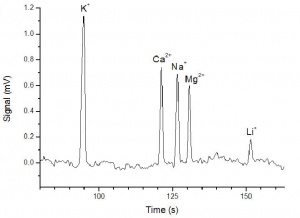Analysis of Inorganic Cations by CE-C4D
The eDAQ C4D system was used to detect the inorganic cations of potassium, calcium, sodium, magnesium and lithium, separated using capillary electrophoresis.
Introduction
The eDAQ C4D system was connected to a purpose-made capillary electrophoresis (CE) instrument at the University of Basel in Switzerland. The cations K+, Ca2+, Na+, Mg2+ and Li+ were then analysed. The method used was similar to experiments previously published: Comparison of Different Contactless Conductivity Detectors for the Determination of Small Inorganic Ions by Capillary Electrophoresis; Pavel Kubáñ, Christopher J. Evenhuis, Mirek Macka, Paul R. Haddad, Peter C. Hauser; Electroanalysis 18, 2006, No. 13-14, 1289 – 1296
Conditions
- Sample: A solution of 10 µM of potassium, calcium, sodium, magnesium and lithium, dissolved in water.
- Buffer: 12 mM histidine and 50 mM acetic acid
- Instrument:
- separation voltage = 30 kV
- recorded separation current = 11 – 12 µA
- Capillary:
- fused-silica from Polymicro Technologies
- outer diameter = 360 µm
- internal diameter = 50 µm
- length = 60 cm
- length to detector = 50 cm
- Injection: gravity siphoning at 10 cm for 15 seconds
- C4D settings
- frequency = 800 kHz
- amplitude = 80 A
- headstage gain OFF
- Data recording:
- lowpass filter = 2 Hz
- range = 10 mV
- sampling rate = 1000 data points per second
Data and Limit of Detection
The figure shows the electropherogram for the 10 µM sample of inorganic cations. From this electropherogram, it can be estimated that the limit of quantitation (LOQ) of potassium, calcium, sodium and magnesium is 1 µM, and that of lithium is 3 µM. The limit of detection (LOD) is thus 0.3 µM for potassium, calcium, sodium and magnesium, and 1 µM for lithium.
